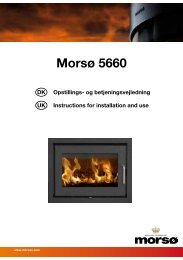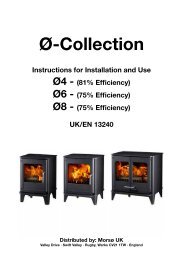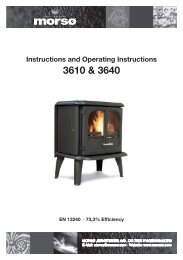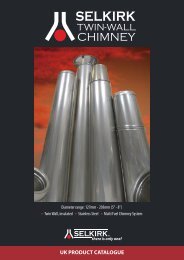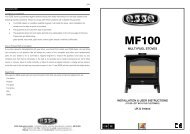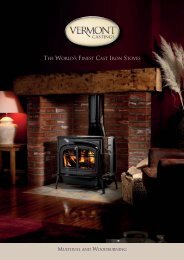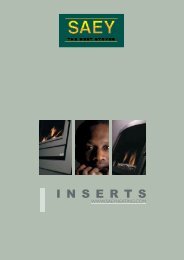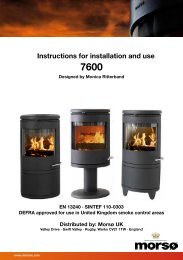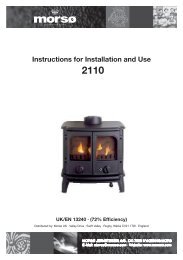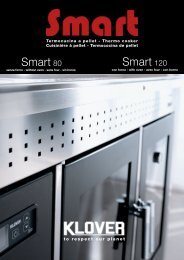OPERATING INSTRUCTIONS Scan Line 500 HETA ... - Stoves Online
OPERATING INSTRUCTIONS Scan Line 500 HETA ... - Stoves Online
OPERATING INSTRUCTIONS Scan Line 500 HETA ... - Stoves Online
Create successful ePaper yourself
Turn your PDF publications into a flip-book with our unique Google optimized e-Paper software.
MaintenanceThe surface of the stove has been treated with heat-resistant paint.The stove should be cleaned with a damp cloth. Any damage to the surface in the form ofchips or scratches can be repaired using touch-up paint, which is available in spray cans. If thestove has become grey in colour due to overheating, touch-up paint of this kind can be used torepaint the stove entirely. However, in this case, the stove should be dismantled and the surfacetreatment should be performed outdoors or in a purpose-built room.Cleaning the glassIncorrect firing, for example using wet wood, can result in the viewing window becomingcovered in soot. This soot can be easily and effectively removed by using proprietary stoveglass cleaner.Changing to back smoke outlet Fig. 13-201314<strong>OPERATING</strong> <strong>INSTRUCTIONS</strong><strong>Scan</strong> <strong>Line</strong> <strong>500</strong>Emptying the ash pan, fig. 5–85 67815 161718Cleaning after sweeping the chimney and replacingthe stones. Fig 9-111920910WarningAny unauthorised modification ofthe stove and any use of non-originalspares will voidthe guarantee.GuaranteeThe stove is prepared for a fresh air intake.The model <strong>Scan</strong>-<strong>Line</strong> <strong>500</strong> stoves are subjected to stringent quality control procedures both11 12throughout the production process and immediately before delivery to the dealer.Therefore, the stoves are guaranteed against defects in manufacturing FOR FIVE YEARS.This guarantee does not cover: Wearing parts/fragile parts such as:• The fire-proof bricks in the combustion chamber.• The smoke baffle.• The glass. • The sealing rope. • The grate frame.Damage resulting from incorrect use Transport costs in connection with repairs carried outunder guarantee Installation/disassembly in connection with repairs carried out under guaranteeShould you have cause to make a complaint, please quote the number on the certificate ofguarantee.5 604/10-2005 - 0037-1156<strong>HETA</strong> A/SDK-LEMVIGEN
Congratulations on your new stove. We are sure that you will be happy with your investment,especially if you follow the advice and instructions we have put together in these operatinginstructions.The <strong>Scan</strong>-line <strong>500</strong> has been approved according to the EN 13240 / NS 3058.Approval means that consumers can be sure, that the stove meets a range of specifications andrequirements intended to ensure that the materials used are of good quality, that the stove doesnot adversely affect the environment, and hat it is economical to use.With your new stove you should have received the following:a. Operating instructions b. Guarantee slipc. A stove glove d. Ashpan coverINSTALLATION <strong>INSTRUCTIONS</strong>:Safety clearances<strong>Stoves</strong> must always be installed in line with national and, if applicable, localregulations. It is important to abide by local regulations regarding setting up chimneys andconnection to same. Therefore, always consult your local chimney sweep beforeinstallation, as you are personally responsible for ensuring that the applicableregulations have been met.Distance regulationsA difference applies to installation next to flammable and non-flammable walls.If the wall is made of non-flammable material the stove can, in principle, be placed flush againstit. However, we recommend leaving a gap of at least 5 cm to facilitatecleaning behind the stove. The minimum distances to flammable material are stated on theboiler plate and are listed in the table on page 4.ImportantDa en brændeovn bliver varm under fyring (mere end 90°C), skal derudvises en fornøden forsigtighed. Børn bør undgå kontakt med ovnen.?Der må ikke opbevares brandbart matriale i rummet under askeskuffen.IMPORTANT1. Make sure there is adequate provision to sweep the chimney.2. Make sure there is adequate ventilation to the room.3. Please note that any extraction fans operating in the same room as the wood-burningstove can reduce the chimney draft – which may have an adverse effect on stovecombustion properties. In addition, this may cause smoke to be emitted from the stovewhen the firing door is opened.4. It must not be possible to cover any air vents.The floorIt is essential to ensure that the floor surface can actually bear the weight of the stoveand a top-mounted steel chimney, if applicable. The stove must stand on a nonflammablesurface such as a steel floor plate or a brick or tile floor. The size of the nonflammablesurface used to cover the floor area must match national and local regulations.The chimney connectionThe chimney opening must follow national and local regulations. However, the area of theopening should never be less than 175 cm2, which corresponds to a diameter of 150mm. If a damper is fitted in the flue gas pipe, there must always be at least 20 cm2 offree passage, even when the damper is in its “closed” position. If local regulationspermit, two contained fireplaces can be connected to the same chimney. However, youmust abide by local regulations regarding the distance between the two connections.Wood-burning stoves must never be connected to chimneys that are also linked to a gasfiredheater. An efficient stove makes high demand on chimney properties – so alwayshave your local chimney sweep evaluate your chimney.Connection to a brick chimneyBrick a thimble into the chimney and seat the flue gas pipe in this. The thimble and fluegas pipe must not penetrate the chimney opening itself, but must be flush with the insideof the chimney duct. Joins between brickwork, the thimble and flue gas pipe must be sealedwith fireproof material and/or beadingConnection to a steel chimneyWhen fitting a connection from a top-output stove directly to a steel chimney, we recommendfitting the chimney tube inside the flue gas spigot so that any soot and condensation drops intothe stove itself rather than collecting on the exterior surface of the stove. Changing smoke outletfrom top-mounted to rear-mounted (see fig. 8–15 on page 6).For connections to chimneys that are run through ceilings, all national and local regulationsregarding distance to flammable material must be followed. It is important that the chimney isfitted with roof support so that the top panel of the stove is not required to bear the entireweight of the chimney (excessive weight may damage the stove).Draft conditionsPoor draft may result in smoke being emitted from the stove when the door is opened. Theminimum chimney draft to ensure satisfactory combustion in stoves of this kind is 12 PA.However, there will still be a risk of smoke emission if the firing door is opened during powerfulfiring. The flue gas temperature at nominal output is 257°C when expelled to an exteriortemperature of 20°C. The flue gas mass flow is 5.4 g/sec. The chimney draft is generated by thedifference between the high temperature of the chimney and the low temperature of the freshair. The length and insulation of the chimney, wind and weather conditions also have aneffect on the ability of the chimney to generate appropriate under-pressure.Reduced draft can occur when:- The difference in temperature is too small – due to insufficient chimney insulation, for example.- The outdoor temperature is too high – in summer, for example.- No wind is blowing. - The chimney is too low and sheltered. - The chimney contains false air.- The chimney and flue gas pipe are blocked.- The house is too airtight (i.e. when there is an insufficient supply of fresh air).Good draft occurs when:- The difference in temperature between the chimney and outdoor air is high.- The weather is fine. - The wind is blowing strongly.- The chimney is of the correct height: at least 4.00 m above the stove and free of the roof ridge.Instructions for use:First firingThe stove has been treated with a heat-resistant coating which hardens at a temperature ofapproximately 250 ºC. This hardening process causes the production of smoke and malodorousfumes, so the room must be very well ventilated.During the first firing, which should be carried out using approximatly 1,6 kg. of wood, thestoking door must be left slightly open and must not be closed until the stove is cold. This is toprevent the sealing rope sticking to the stove.FuelYour new stove is EN approved for firing with wood fuel. You must therefore only burn clean,dry wood in your stove. Never use your stove to burn driftwood, as this may contain a lot of saltwhich can damage both the stove and the chimney. Similarly, you must not fire your stove withrefuse, painted wood, pressure-impregnated wood or chipboard, as these materials can emitpoisonous fumes and smoke. Correct firing using well seasoned wood provides optimal heatoutput and maximum economy. At the same time, correct firing prevents environmentaldamage in the form of smoke and emmissions and also reduces the risk of chimney fires.If the wood is wet and inadequately seasoned, a large proportion of the energy in the fuel willbe used to vaporise the water, and this will all disappear up the chimney. Thus it is importantto use dry, well seasoned wood, i.e. wood with a moisture content of no more than 18%. Thisis achieved by storing the wood for 1–2 years before use. Pieces of firewood with a diameter ofmore than 10 cm should be split before storing. The pieces of firewood should be of anappropriate length (approx. 25–30 cm) so that they can lie flat on the bed of embers. If youstore your wood outdoors, it is best to cover it.Examples of fuel values of different woodsFuel type / number of cubic metres per 1,000 litres of oilOak / 7.0 Beech / 7.0 Ash / 7.2 Birch / 8.0 Elm / 8.9 Common spruce /10.4Chimney firesIn the event of a chimney fire – which often results from incorrect operation or protracted firingwith moist wood – close the door and shut off the secondary/start-up air supply to smother thefire. Call the fire department.Lighting andTo open the flow of secondary air, use the operating handle atcombustionthe back of the side panel. The secondary airflow is completelyFig. 1 Fig. 2open in top position, fig. 1. Shut off the secondary airflowgradually by lowering the handle. The supply is completelyshut off when the handle is at its bottom position, fig. 2.To open the start-up airflow for the stove, pull the handle onthe start-up mechanism as far to the right-hand side of thestove (as seen from the front) as possible. See fig. 3. To closethe start-up airflow for the stove, push the handle on the startupmechanism as far to the left-hand side of the stove (as seenfrom the front) as possible. See fig. 4.To regulate the volume of combustion air(secondary air), position the operatinghandle at the back of the side panel betweenclosed (fig. 2) and completely open (fig. 1).Fig. 3 Fig. 42 3 4LightingTo ignite the fuel, use fire lighters, small paraffin ignition bags or small pieces of wood placedon the bottom grate. Place larger pieces of wood on top of this kindling material, at rightangles to the firing, doors. Completely open the secondary air supply and leave the firing doorajar – i.e. approx. 1 cm open. Once the fire has taken a good hold of the fuel and the chimneyhas heated up (after about 10 min) close the firing door. We recommend that you burn theentire first firing with the secondary air supply fully open to make sure that the chimney isthoroughly heated.RefiringYou should normally refire the stove while there is still a good layer of embers. Distribute theembers across the bottom grate, place pieces of fuel (max. 2 kg) on the embers in a single layerperpendicular to the firing opening. Close the firing door and fully open the start-upmechanism. The wood will then ignite very quickly – i.e. in 30 seconds or 1 minute. Whenthe wood is burning with a steady flame, close the start-up mechanism. Then adjust the secondaryairflow to the level required. For nominal operation (5 kW), the secondary air supplyshould be approx. 70% open. When firing, take care not to place the pieces of fuel too closelytogether, as this will result in poor combustion and insufficient exploitation of the fuel. Pleasenote that the start-up mechanism must not remain open during normal operation of the stove,as this may lead to overheating. It must only be used until the fuel is burning with a steady flame.Reduceret afbrændingThe stove is well-suited to intermittent use. If you wish to operate the stove with reduced output,simply insert smaller volumes of wood at each firing, and apply a lower airflow. However,remember that the secondary combustion air supply must never be shut off completely duringfiring. It is important to keep a good bed of embers. Gentle heat is released when the fire settles- i.e. when the wood no longer generates flames and has been converted to glowing embers.Optimal firingTo achieve optimal firing and the highest possible effect, it is important to make sure that theair supply is used correctly. As a general rule, the secondary air is to be used to control the fireto ignite the flue gases. This produces a high effect and keeps the glass panel completely clearof soot as the secondary air “washes” down over it. Please note that the stove will, naturally,produce soot if both the start-up mechanism and secondary air intakes are closed completely.This will prevent oxygen from being drawn into the stove, and the viewing window and otherparts will become covered with soot. If this situation is combined with firing with wet wood,the build-up of soot can become so thick and sticky that the sealing rope can, for example,become detached when the door is opened the next day.Risk of explosionAfter you add new fuel, it is very important that you do not leave the stove unattendeduntil the wood is burning constantly. This will normally occur within 30 to 60 seconds.A risk of explosion can possibly arise if too much wood is placed in the stove. This may resultin the production of large volumes of gas, and this gas can explode if the intake of primaryand secondary air is insufficient.It is an advantage always to leave some ash lying in the bottom of the combustion chamber.Take care when emptying the ash pan, as cinders can continue to burn in the ash for longperiods of time.Stove data table in accordance with EN 13240 testing.Stove Nominel Smoke Fuel Draught Nominal Heat Distance to flammable Distance Stovetype røggas stub volume min. output output materials in mm to furnitures weighttemperatur tested behind at the from the<strong>Scan</strong>-line c° mm kg mbar kW kW the stove sides stove in mm kg<strong>500</strong> 257 Ø150 1,6 0,12 5 5 150 400 900 113The nominal output is the output to which the stove has been tested.The test was carried out with the secondary air supply almost 70% open.Operational problemsThe chimney must be swept at least once a year, we recommend the use of a NACS (nationalassociation of chimney sweeps) registered chimney sweep. In the event of smoke or malodorousfumes being produced, you must first check to see whether the chimney is blocked. Thechimney must, of course, always provide the minimum draught necessary to ensure that it ispossible to regulate the fire. Please note, however, that chimney draft is dependent on theweather conditions. In high winds, the draft can become so powerful that it may be necessaryto fit a damper in the flue gas pipe to regulate the draft. When cleaning the chimney, soot andother deposits may come to fall on the smoke plate. In cases where the wood burns tooquickly, this may be due to excessive chimney draught. You should also check to make surethat the door seal and ashpan seal is intact and correctly fitting.If the stove it generating too little heat, this may be because you are firing with wetwood. In this case, much of the heating energy is used to dry the wood, resulting in poorheating economics and an increased risk of soot deposits in the chimney.



